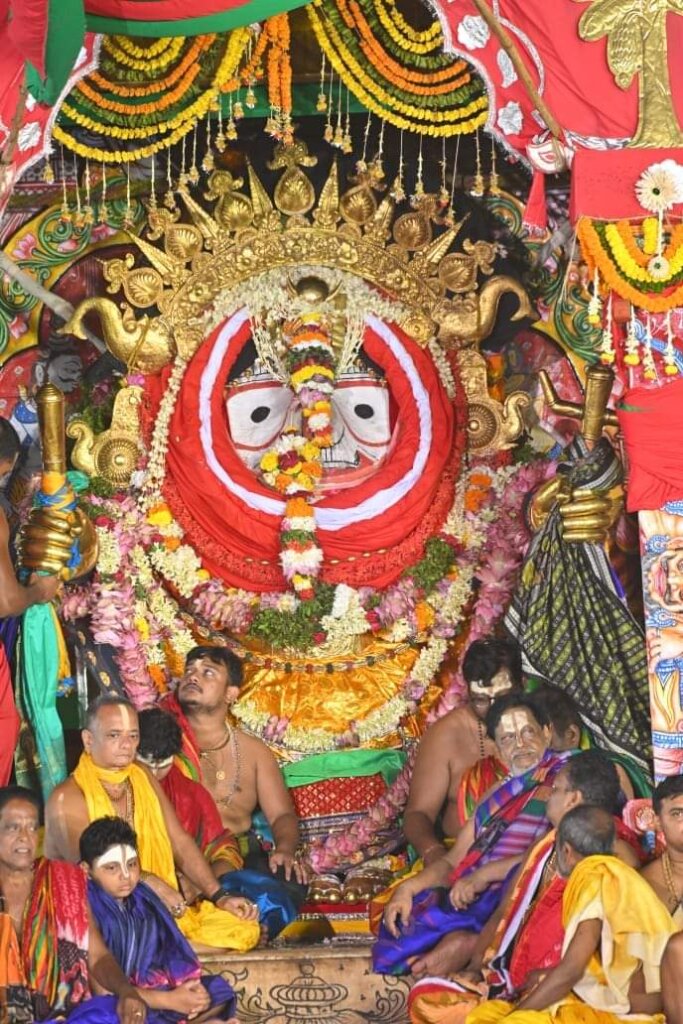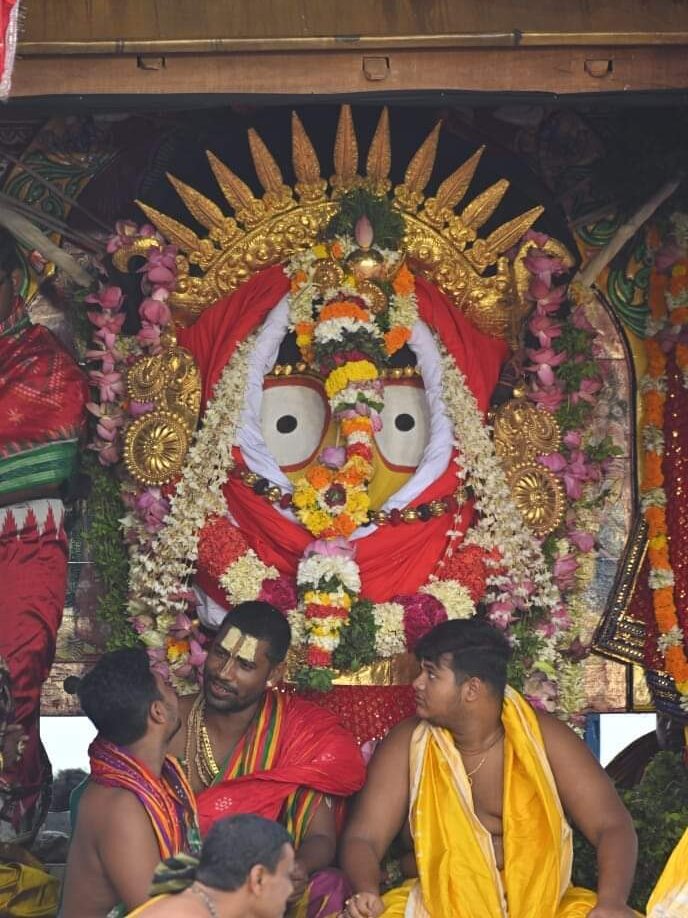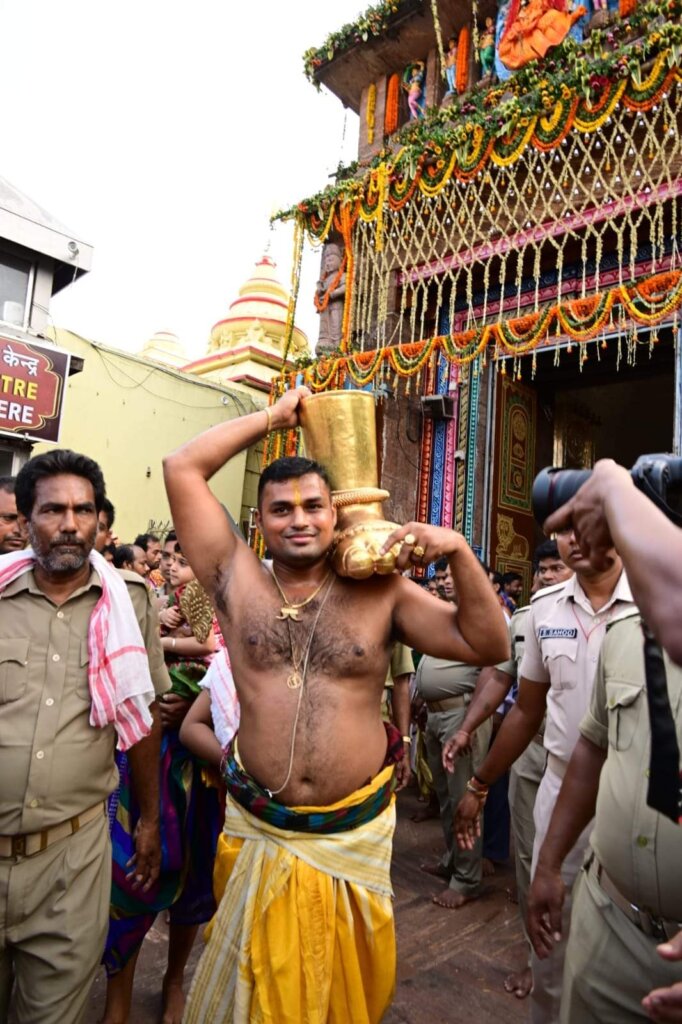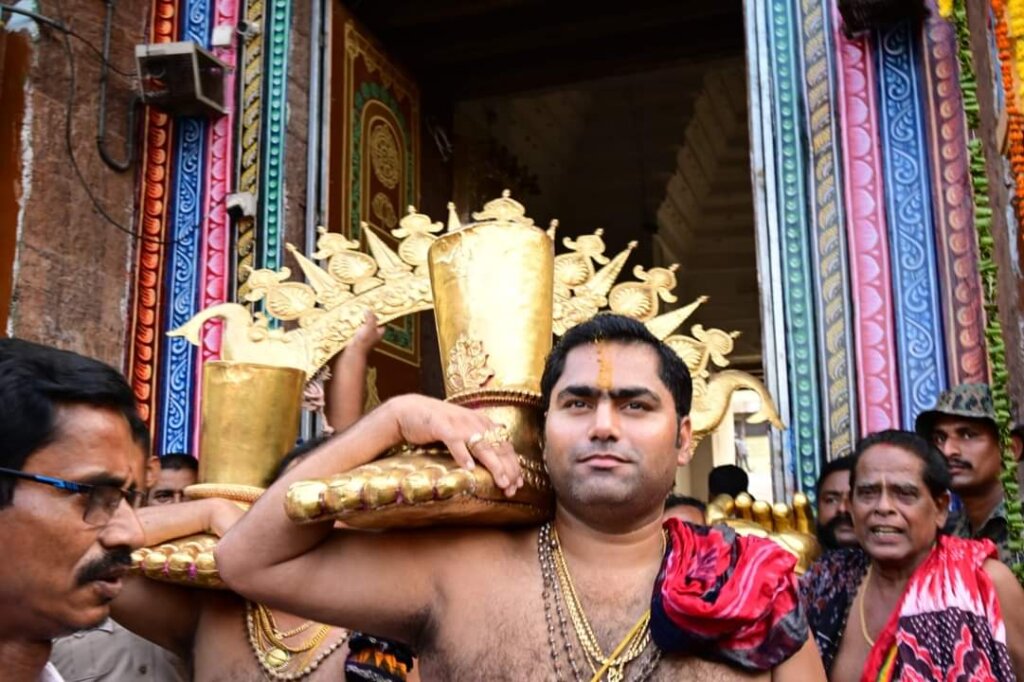Suna Besha, also known as Raja Besha or Rajarajeshwara Besha, is a Rath Yatra event in which Lord Jagannath and other deities Balabhadra and Goddess Subhadra are adorned with beautifully carved Gold jewelry and are loaded with precious stones and the yellow shine of the Gold from head to toe.
It is observed on Ashadha Shukla Ekadashi Tithi, the 11th bright fortnight in Asadha, the day after the return of the Deities from Gundicha Temple. Balabhadra and Subhadra are two of the 32 Bashas or manifestations of Lord Jagannath. Suna Besha is one of the most admired by Devotees since it is performed in the huge chariots. Bada Tadhau Besha is another name for this. The deities, riding on their chariots, adore the golden attire or the Suna Besha, with hands, arms and crown made of solid gold.
Suna Besha is usually observed five times a year. It occurs on October’s Bijaya Dashami, November’s Kartika Purnima, December’s Pausa Purnima, January’s Magha Purnima, and July’s Asadha Ekadashi. Suna Besha is a combination of two words: ‘Suna,’ which means “gold,” and ‘Besha,’ which means “costume.”
Suna Besha occurs on Bahuda Ekadashi during the Rath Yatra on the chariots stationed at the Lion’s Gate, also known as Singhadwara. The remaining four Suna Beshas can be seen on the Ratna Singhasana inside the temple. Lord Jagannath is also adorned with a gold Chakra or disc on the right hand and a silver conch on the left. On the other hand, Lord Balabhadra is adorned with a gold plough on the left hand while a golden mace adorns his right hand.

Suna Besha was first introduced in 1460 A.D. under the reign of King Kapilendradeva. When King Kapilendradeva returned home triumphant after defeating the lords of the Deccan (Southern India), he delivered a tremendous bounty in 16 cartloads. The trophies he collected were made of diamonds and gold. He gave all the booty to Lord Jagannath the day he landed in Puri. He directed the temple priests to have jewellery made from the gold and diamond he had provided to adorn the deities during the Ratha Yatra festival. After the Bahuda Yatra, the deities Jagannatha, Balabharda, and Subhadra are decked with this jewelry.

The Lords’ gold ornaments are kept in the temple’s treasury, known as Bhitara Bhandara ghara. The bhandara nikap priests or shop in-charge deliver the requisite amount of gold from the bhandara ghar before 1 hour and hand it over to the puspalaka and daitapati priests on the chariots, who are guarded by armed policemen and temple officials. The daitapati priests are in charge of decorating the Deities’ bodies with gold jewelry. On their various chariots, the three goddesses are adorned with glittering gold jewelry.
Here are the details of types of golden ornaments used during Suna Besha:
1. Sri Hasta – Golden Hand.
2. Sri Payar – Golden feet.

3. Sri Mukuta – Golden big crown.
4. Sri Mayur Chandrika – A golden peacock feather used by Lord Jagannath as Sri Krishna headpiece.
5. Sri Chulapati – A golden ornament worn traditionally on the forehead to increase the beauty of the face.
6. Sri Kundal – Golden earring of hanging round ball type.
7. Sri Rahurekha – A half square shaped golden aura around the face of the deities.

8. Sri Mala – (Necklaces with Several Designs made of gold)
PADAM MALA -Lotus Shaped.
SEVATI MALA -Shaped Like Small Sunflower.
AGASTI MALA -Moon Shaped flower design.
KADAMBA MALA -Kadamba Flower Design (Round ball shape).
KANTE MALA -Big Gold Beads Design.

MAYUR MALA -Shaped in Peacock feathers.
CHAMPA MALA -Shaped liked Yellow champa Flower.
9. Sri Chita – It represents the third eye of Lords and placed on forehead of the deities.
10. Sri Chakra – Golden Wheel.
11. Sri Gada – Golden bludgeon.
12. Sri Padma – Golden lotus.
13. Sri Sankha – A silver conch.
The treasury comprises 150 gold pieces, according to the “Records of Rights,” including three necklaces of 120 tola or 1.4 kg weight each of the limbs of hands and feet. Lord Jagannath and Balabhadra were cast in gold and weighed 818 tola (9.54 kg) and 710 tola (8.28 kg). There are also ornamental crowns of the deities Jagannatha, Balabhadra, and Subhadra weighing 610 tolas or 7.12 kg, 434 tola or 5 kg, and 274 tola or 3.2 kg, respectively. According to temple sources, the entire weight of the gold jewelry used to adorn the idols weighed more than 208 kg when they were first fashioned in 138 designs. It is thought that anyone who sees the Lord in Suna Besha gets free of all his bad Karmas. A huge number of the crowd can be seen in front of the temple to feel the power of the Lord on this day.
“Jai Jagannath”
Source:SE







 Finance
Finance







